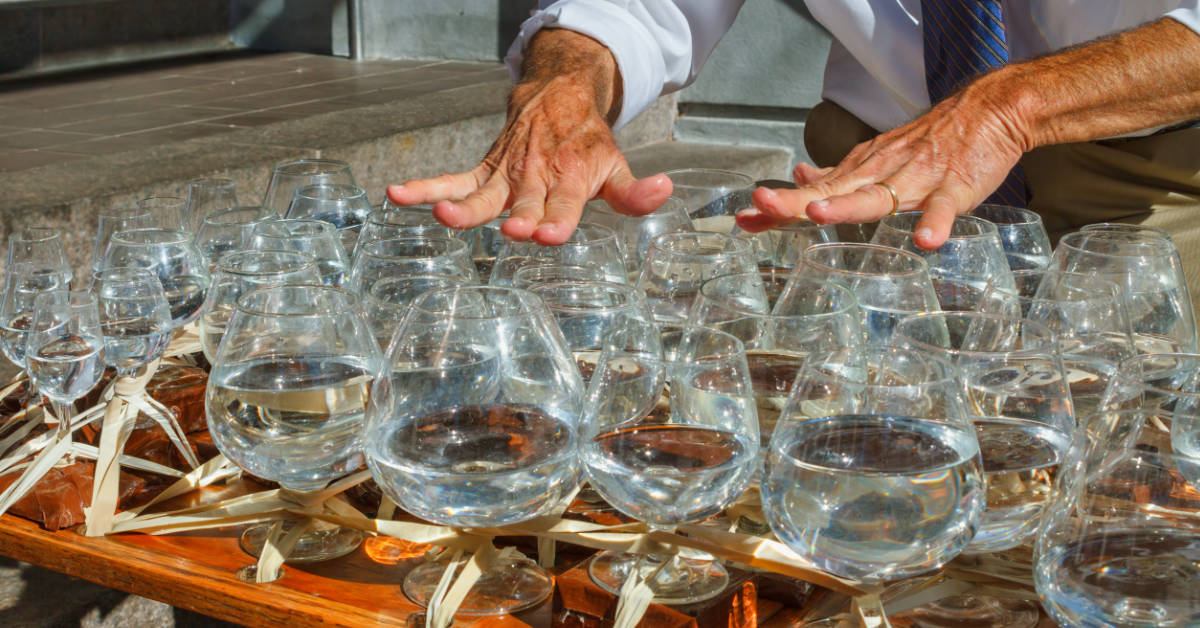You will most likely have already seen in action or experimented, in an absolutely amateur way, the glasspiel, also known as musical glasses or singing glasses.
More difficult, however, is that you have witnessed a performance of glassharmonica: the glass harmonica.
The glasspiel as predecessor
In the major cities, some street artists cheer up passers-by with the sound of glasspiel, a friction-operated idiophone musical instrument. Made up of a series of glass glasses, of different sizes and filled with different quantities of water, the instrument produces a vast number of notes thanks to the rubbing produced by the performer's moistened fingers on the rim of the glasses.
The glasspiel, very popular in England and in Bohemia during the 18th century, however, it was replaced by the glassharmonica.
The invention and the instrument
La glassharmonica it was invented in 1762 by the eclectic Benjamin Franklin, one of the founding fathers of the United States of America, who in London had the opportunity to appreciate theglass harp devised by Richard Pockrich (a scientifically structured glasspiel) and changed the arrangement of the glass cups, placing them concentrically, in order of size, along a horizontal axis.
The inventor's initiative was aimed at making the instrument independent of the use of water. An objective achieved thanks to the collaboration with Charles James, a skilled glass blower.

How do you play it?
Not unlike the piano, the glass harmonica produces sounds as a function of the movement of the musician's hands, which impress the notes thanks to the touch on the glass caps, which rotate at a constant speed, via a pedal or an electric motor that activates the rotating rod.
Thus, by rubbing, a sound that is both velvety and crystalline is emitted, more serious in the case of the larger caps (to the left of the player) and higher in that of the smaller caps (to the right). The performer is also facilitated by the presence of colored stripes indicating sharps and flats.
The artists of the glass harmonica
The glassharmonica was welcomed by composers of the caliber of Mozart, Beethoven, Naumann and Donizetti, and as many as 300 were made works of classical music for this instrument, studied even by Maria Antonietta.
But the success of the glass harmonica was short and limited, although to date there have been some attempts at recovery. This is the case of the French musician Thomas bloch (specializing in rare instruments), which boasts over 3000 concerts and more than 150 recordings and featuring with numerous artists, including John Cage, Daft Punk, Radiohead, Damon Albarn and Gorillaz.
The glassharmonica was also used, among others, by Pink Floyd for the song Shine On You Crazy Diamond, while David Gilmour included it in the introduction of A Pocketful of Stones.
The cursed charm of the glassharmonica: saturnism and madness
The glass harmonica, controversial and, for some, even cursed, is cloaked in an aura of mystery, which depends as much on the material it is made of as on the sound it produces.
The high quantity of lead, contained in ancient glass mixtures, connected to prolonged handling of the material, could in fact have caused phenomena of saturnism, a serious chronic disease which in case of acute intoxication can cause intense abdominal pain, nausea, vomiting, hemolytic anemia, jaundice, renal failure, convulsions and mental disorders.
But above all it is the sound of the glassharmonica itself that causes profound disturbance. It is no coincidence that Gaetano Donizetti used it in the opera "Lucia di Lammermoor", to mark the restless tones of the "madness scene".
Il penetrating soundThe ethereal and sinister nature of the glass harmonica was long considered detrimental to the mental stability of musicians and listeners. According to the German musicologist Friedrich Rochlitz (1769-1842), the instrument “excessively stimulates the nerves, plunging the performer into persistent depression and a bleak, melancholy mood, prone to self-annihilation. Those who suffer from any nervous disorder should not play it, as do those who are not yet ill and those who are subject to melancholy moods."
If you are not afraid of the disturbing effects of the glass harmonica and want to lose yourself in the enchantment produced by this glass instrument, we recommend:
Sources: wikipedia.org, Terzopianeta.info, wheremagichappens.it, wom.altervista.org, baroque.it, losbuffo.com



